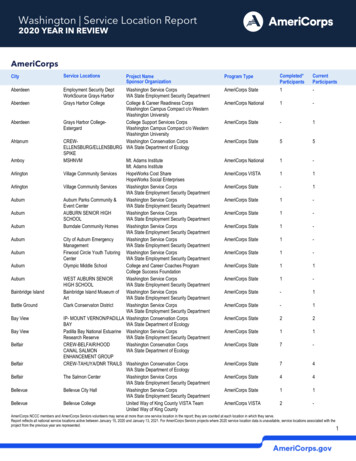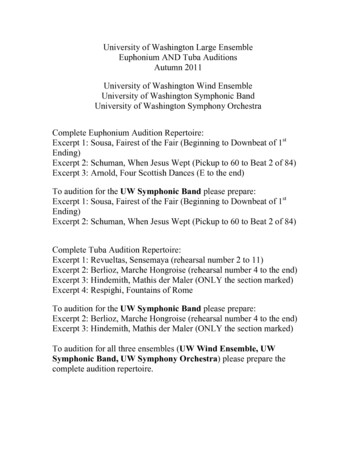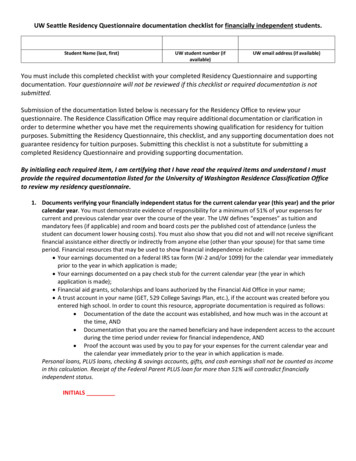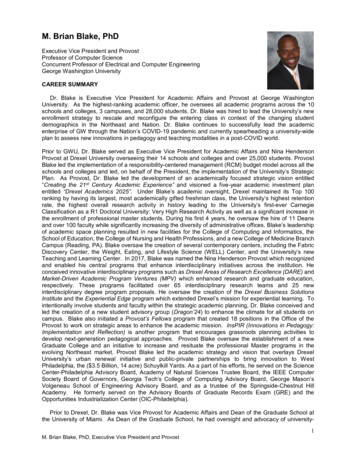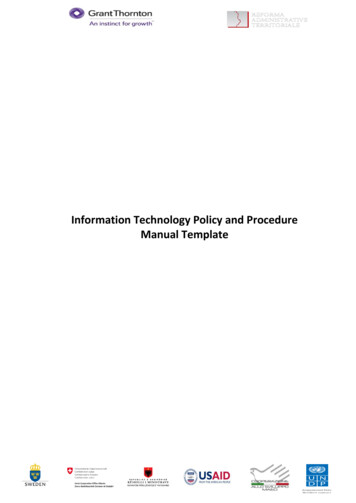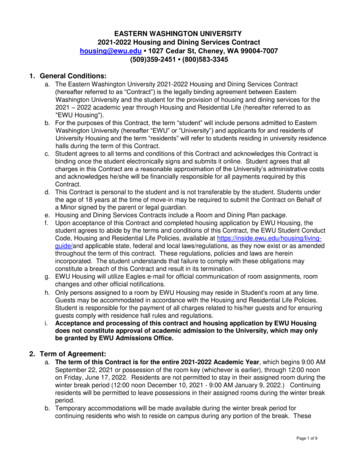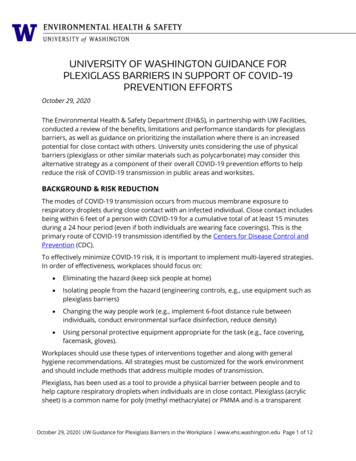
Transcription
UNIVERSITY OF WASHINGTON GUIDANCE FORPLEXIGLASS BARRIERS IN SUPPORT OF COVID-19PREVENTION EFFORTSOctober 29, 2020The Environmental Health & Safety Department (EH&S), in partnership with UW Facilities,conducted a review of the benefits, limitations and performance standards for plexiglassbarriers, as well as guidance on prioritizing the installation where there is an increasedpotential for close contact with others. University units considering the use of physicalbarriers (plexiglass or other similar materials such as polycarbonate) may consider thisalternative strategy as a component of their overall COVID-19 prevention efforts to helpreduce the risk of COVID-19 transmission in public areas and worksites.BACKGROUND & RISK REDUCTIONThe modes of COVID-19 transmission occurs from mucous membrane exposure torespiratory droplets during close contact with an infected individual. Close contact includesbeing within 6 feet of a person with COVID-19 for a cumulative total of at least 15 minutesduring a 24 hour period (even if both individuals are wearing face coverings). This is theprimary route of COVID-19 transmission identified by the Centers for Disease Control andPrevention (CDC).To effectively minimize COVID-19 risk, it is important to implement multi-layered strategies.In order of effectiveness, workplaces should focus on: Eliminating the hazard (keep sick people at home) Isolating people from the hazard (engineering controls, e.g., use equipment such asplexiglass barriers) Changing the way people work (e.g., implement 6-foot distance rule betweenindividuals, conduct environmental surface disinfection, reduce density) Using personal protective equipment appropriate for the task (e.g., face covering,facemask, gloves).Workplaces should use these types of interventions together and along with generalhygiene recommendations. All strategies must be customized for the work environmentand should include methods that address multiple modes of transmission.Plexiglass, has been used as a tool to provide a physical barrier between people and tohelp capture respiratory droplets when individuals are in close contact. Plexiglass (acrylicsheet) is a common name for poly (methyl methacrylate) or PMMA and is a transparentOctober 29, 2020ᅵ UW Guidance for Plexiglass Barriers in the Workplace ᅵ www.ehs.washington.edu Page 1 of 12
thermoplastic often used as an alternative to glass. PMMA is an alternative topolycarbonate, but does not offer as much strength, ultraviolet light tolerance, ability topolish, heat or chemical resistance.BENEFITS OF PLEXIGLASS BARRIERS Barriers can block respiratory droplets produced by a person who is in close contactwith the barrier. Barriers can provide a physical separation between people to support social andphysical distancing efforts. Barriers are appropriate in a variety of settings, including public areas, retail settingsand spaces where it is difficult to maintain 6 feet of separation between individuals. Barriers can provide a level of protection from surface contamination in thepersonal workspace. Use of barriers are consistent with recommendations from CDC as a component ofexposure controls. Barriers may cause minimal disruption to work and business practices in manyworkplaces. Barriers can serve as a component of a long-term strategy to reduce risk for otherviruses that spread by similar modes of transmission (e.g., influenza). Plexiglass barriers are nonporous and may be disinfected. Barriers can provide a sense of safety assurance for workers and customers, andvisitors.LIMITATIONS OF PLEXIGLASS BARRIERS Barriers do not provide a zero-risk solution. They do not address all possible modesof transmission, such as aerosol transmission, or fully protect anyone from COVID19. Barriers do not replace the need to maintain 6 feet of separation betweenindividuals when possible. Barriers do not replace the need to follow other public health requirements such aspracticing good hygiene (e.g., washing hands, not touching your face, staying homeif you are ill), the need to wear face coverings and PPE, or other requirements andrecommendations from UW EH&S, CDC, or the state of Washington. There may be constraints in the physical/structural environment that preventinstallation of appropriately sized barriers.October 29, 2020ᅵ UW Guidance for Plexiglass Barriers in the Workplace ᅵ www.ehs.washington.edu Page 2 of 12
Barriers may not be feasible or appropriate in all workspaces or for all workactivities. If not designed or installed properly for the specific work environment, barriers mayobstruct or interfere with the ventilation system airflow, and fire and life safetyprotection systems (e.g., fire alarm notification devices, fire sprinklers, fire pullstations). Barriers may break if individuals lean against the material which may expose sharpedges. Consider polycarbonate if the barrier may be subjected to individuals leaningor pushing against it.GUIDELINES FOR INSTALLATIONBarriers should be sized to block face-to-face pathways between individuals and mustcreate a distance of at least 6 feet for any indirect pathways.Business WireMass TransitQuad City TimesOctober 29, 2020ᅵ UW Guidance for Plexiglass Barriers in the Workplace ᅵ www.ehs.washington.edu Page 3 of 12
Below are examples of possible University environments and circumstances in whichbarriers can be beneficial. This list is not exhaustive and serves to generate conversationsabout potential implementation. Retail point of sale Buffet lines if a sneeze barrier is not built-in Grocery or dining checkout Ticket sales and ticket scanners Shuttle driver protection Resident hall front desks Library circulation Between undivided cubicles and workstations Reception desks Facilities Stores equipment/supply desk locations Pharmacy pick up or drop offPRIORITIZATION OF PLEXIGLASS BARRIERSPlexiglass barriers offer the ability to separate individuals that may need to be in closeproximity to others. Due to increased requests for plexiglass barrier installation it isimportant to prioritize the areas of installation to ensure higher risk areas receive barriersfirst. Prioritization considerations should include certain factors such as workplace typeand risk level, occupant and visitor frequency, density, placement, and pedestrian pathwaydensity.The prioritization of plexiglass barriers falls within the engineering controls section of thehierarchy of controls. Eliminating the hazard altogether is the best option, however, it is notalways possible and therefore engineering controls may be implemented to reduce thehazard risk.Plexiglass BarriersOctober 29, 2020ᅵ UW Guidance for Plexiglass Barriers in the Workplace ᅵ www.ehs.washington.edu Page 4 of 12
When considering the prioritization of plexiglass barrier installation it is important todetermine the risk level, frequency, and volume of contact with the public and coworkers,and where adequate controls are not able to be implemented at the installation location.PrioritizationLevelArea DescriptionHigherAreas of high frequency and high volume of contact with members of the general public,and lack of other controlsExamples: Food service – cashiers, serving counters Higher volume retail cashier lanes Higher volume screening and check-in areas (e.g., medical facilities, first point ofentry) Ticketing/transportation desks/kiosks Higher volume reception or information desks Transportation shuttles and buses (high volume)Areas of frequent contact with members of the general public or coworkers, and lack ofother controlsMediumExamples: Lower volume reception, information and administrative stations Open work areas with close proximity workstations that lack barriers and othercontrols Lower volume retail locations Transportation vehicles, including research vesselsAreas that do not require contact with people and/or areas with minimal occupationalcontact with members of the general public or coworkers.LowerExamples: Lower volume and density offices where social/physical distancing is strictly adheredto and minimal contact with others Areas with other installed engineering controls that are as effective or moreeffective than plexiglass barriersPlexiglass dimensionsEach plexiglass installation area will require individual considerations regarding specificplexiglass dimensions based upon specific building or furniture layout, and occupant orvisitor stationing. The overall goal is to prevent respiratory droplets from one individualtravelling through the air and landing on another individual and potentially causinginfection. The plexiglass barriers will need to be of a certain minimum size, determined bythe specific installation area.October 29, 2020ᅵ UW Guidance for Plexiglass Barriers in the Workplace ᅵ www.ehs.washington.edu Page 5 of 12
The following spatial arrangements between individuals will need to be considered duringinstallation of plexiglass barriers: Sitting near sitting Sitting near standing Standing near standing Individual movements within area High density pedestrian flow Multiple individuals providing services at a single locationAnthropometric data provided by the CDC states that themeasured average height for adults aged 20 and over in theUnited States is between 63.6 and 69.0 inches. The average sittingheight for individuals varies based on chair height and type;therefore, plexiglass vertical heights will need to be designedspecific to the location, unless the vertical height dimensions canbe applied across similar workstations in a single Work Request.To block respiratory droplets from standing individuals, the tophorizontal edge height of the barrier should be at least 72inches, or 6 feet, above the floor and accounts for the tallestaverage individual height with the addition of a buffer.6’Ergonomics and communication considerationsThe installation of plexiglass barriers has the potential for increasing the risk ofmusculoskeletal injuries in certain settings where the plexiglass barrier diverts normalbody motion. If the plexiglass barrier consists of a pass-through or other penetration inwhich body mechanics are altered from normal motion to forceful motion, over time thosedeviations from more natural and comfortable body motion may cause musculoskeletalpain or injury.Another factor to consider is how the plexiglass shield willaffect communication between individuals. The plexiglassbarrier may interfere with voice communication causingindividuals to lean forward from the natural sitting orstanding position to project their voice. The combination ofthe barrier with facemasks or cloth face coverings may alsocause communication issues. In areas where plexiglassbarriers are determined to interfere with communication, theDK Hardwareinstallation of a no-draft speak-through or an electronic communication device should beconsidered.October 29, 2020ᅵ UW Guidance for Plexiglass Barriers in the Workplace ᅵ www.ehs.washington.edu Page 6 of 12
For barriers already in place, employees that need ergonomic assistance can contact EH&Sat ehsergo@uw.edu or 206.543.7388.ADDITIONAL INSTALLATION CONSIDERATIONSVentilation design interference potentialThe installation of plexiglass barriers may require customization at each specific locationwhere deemed necessary. Due to the variation in plexiglass barrier dimensions, it isimportant to consider how the barrier will affect building airflow and overall ventilation ofthe space. During the design phase of the installation process, it is important to examinethe ventilation design with regard to the location of supply and return air registers so thatthe barriers do not block air flow within spaces. Depending on the scope and location ofthe project, a review by UW Facilities Engineering Services may be needed as part of theWork Order process to determine potential ventilation impacts and solutions.Regulated building materialsMany older buildings may be constructed of materials that may contain asbestos orsurfaces coated with lead-containing paint. UW Facilities will consult historical data and/orconduct a hazardous materials survey to ensure building materials containing regulatedmaterials are managed properly prior to disturbance through the installation process.Additional information about regulated building materials may be found on the EH&SAsbestos and Other Regulated Building Materials webpage.PLEXIGLASS (ACRYLIC SHEETING) PERFORMANCE STANDARDS ANDINSTALLATION CONSIDERATIONSPlexiglass installed in UW-owned buildings should meet certain standards to ensure properperformance for the intended application. Prior to installation, the following should bereferenced to verify the plexiglass type will meet the requirements of the installationpurpose and location. Barrier construction material must be compatible with the cleaning and disinfectantproducts used to clean the barrier and surrounding area. ASTM D4802-16 Standard Specification for Poly(Methyl Methacrylate) Acrylic PlasticSheet ANSI Z97.1-2015 Safety Glazing Materials Used in Buildings – Safety PerformanceSpecifications and Methods of Test (as applicable) Food Service AreasoANSI 2-2014 Food EquipmentOctober 29, 2020ᅵ UW Guidance for Plexiglass Barriers in the Workplace ᅵ www.ehs.washington.edu Page 7 of 12
Location specific requirements and considerationsoRadiation safety considerations: oLead-lined plexiglass or lead acrylic barriers must meet the minimumlead equivalences for radiation shielding.Building and fire safety considerations: Ensure 18 inches below ceiling to prevent interference with firesprinkler spray patterns. If full height barriers are needed, EH&S will need to assess anddetermine if new fire safety devices will be required. Installation ofnew fire sprinkler or fire alarm devices may be necessary. Barriers must not interfere with existing corridors, aisles or othersimilar open pathways intended for exiting. Barriers that interferewith existing exit routes must be reviewed by EH&S.CLEANING AND DISINFECTINGIt is important to consider the appropriate cleaning and disinfecting chemicals for thebarrier material installed in your area. Using compatible cleaning and disinfectingchemicals will help prevent abrasion and damage to the plexiglass barriers.CleaningFirst, clean the plexiglass barrier by using mild soap and water to remove any bulk dirt anddebris buildup. Lightly scrub the plexiglass surface with a non-abrasive sponge or cleancloth such as microfiber. Use a dry non-abrasive or microfiber cloth to dry the plexiglasssurface in preparation for disinfectant application.DisinfectingAcrylic Materials Do not use alcohols (e.g., ethanol or isopropanol) or solvents (e.g., acetone). Use dilute quaternary ammonium based compounds, 5-6% dilute bleach, or 3-5%dilute hydrogen peroxide.Polycarbonate Materials Do not use ammonia-based compounds (e.g., ammonia, quaternary ammoniumbased chemicals). Use dilute solutions such as less than 10% sodium hypochlorite, ethanol,isopropanol, or 3-5% dilute hydrogen peroxide.October 29, 2020ᅵ UW Guidance for Plexiglass Barriers in the Workplace ᅵ www.ehs.washington.edu Page 8 of 12
PLEXIGLASS INSTALLATION REQUEST PROCESSTo request plexiglass installation, complete and submit the Plexiglass Barrier InstallationRequest Form (attached) that has been signed by the unit head or designee to UWFacilities. It is important to provide the requested information on the form to assist UWFacilities with prioritizing and streamlining the installation. UW Seattle: Submit the request form to the UW Facilities Care Team atcareteam@uw.edu. UW Bothell: Submit the request form to UW Bothell Facilities Services via the OnlineWork Order Request. UW Tacoma: Submit the request form to UW Tacoma Facilities Services via theOnline Work Order Request.The UW Facilities units will consult with EH&S and as needed, Engineering Services on theinstallation requests. For general questions about plexiglass use and installation, contactEH&S at 206-543-7262 or ehsdept@uw.edu.Please note: UW Medicine has an internally established barrier installation process. Pleaseconsult with UW Medicine for barrier installation at UW Medicine facilities.RESOURCESUW EH&S Asbestos and Other Regulated Building MaterialsUW EH&S Cleaning & disinfectionUW COVID-19 Facts & ResourcesUW EH&S Ergonomics2015 Seattle Building CodeWhat to do if you’re sickGuidance for barriers at pharmaciesATTACHMENT: PLEXIGLASS BARRIER INSTALLATION FORMOctober 29, 2020ᅵ UW Guidance for Plexiglass Barriers in the Workplace ᅵ www.ehs.washington.edu Page 9 of 12
Appendix A:PLEXIGLASS BARRIER INSTALLATION REQUEST FORMThe Environmental Health & Safety department (EH&S), in partnership with UW Facilitiesprovides guidance on prioritizing the installation of barriers where there is an increasedpotential for close contact with others. Review the Guidance for Plexiglass Barriers inSupport of COVID-19 Prevention Efforts prior to completing this form.Please note: UW Medicine has an internally established barrier installation process. Please donot complete this form for UW Medicine facilities.Organization/Department:Unit:Building/ Installation Location:Room(s):Completed by / Contact Person:COVID-19 Supervisor Name and Job Title:Approved by Department/Unit Leader orDesignated Person?Budget Number:Yes Plexiglass Barrier Installation Description: (Include quantity, number of areas, dimensions)I am aware that plexiglass barriers do not replace theneed to maintain 6 feet of separation betweenindividuals (when possible), or the need to followother COVID-19 prevention practices such aspracticing good hygiene, or the need to wear facecoverings and personal protective equipment.(select)October 29, 2020ᅵ UW Guidance for Plexiglass Barriers in the Workplace ᅵ www.ehs.washington.edu Page 10 of 12
Installation PriorityProposed Installation AreaHigherMediumLowerFood service – cashiers, serving countersHigher volume retail cashier laneHigher volume screening and check-in areaTicketing/transportation desk/kioskHigher volume reception or informationdeskOther – Please describe:Transportation shuttle and/or busLower volume reception, information, andadministrative stationsOpen work area with close proximityworkstation that lacks barriers or othercontrolsLower volume retail locationTransportation vehicle (e.g., research vessel)Other – Please describe:Lower volume/density office wheresocial/physical distancing is strictly adheredwith minimal contactArea with other installed engineering controlsthat are as effective or more effective thanplexiglass barriersOther – Please describe:Installation Evaluation QuestionsYesNoN/AUnknownDoes the barrier need to be fixed in place?Does the barrier need to be full height, floor to ceiling?Does the barrier need to be rated for radiation shielding?Will the barrier interfere with fire sprinkler spray patterns?(i.e., less than 18 inches from sprinkler head)Could the barrier interfere with emergency egress routesor fire life safety equipment (e.g., strobes, audible alarms)?Could the barrier interfere with building ventilation supplyor exhaust?Could the barrier interfere with voice communication?(i.e., potential need for no-draft speak-through orelectronic communication device)Is there a potential for individuals to lean against thebarrier?Does the barrier need to provide privacy? (i.e., opaquematerial)October 29, 2020ᅵ UW Guidance for Plexiglass Barriers in the Workplace ᅵ www.ehs.washington.edu Page 11 of 12
Photographs (please include photos to assist UW Facilities with work order process)Please submit the completed and signed Plexiglass Barrier Installation Request Form to:UW Seattle: UW Facilities Care Team at careteam@uw.eduUW Bothell: UW Bothell Facilities Services Online Work Order RequestUW Tacoma: UW Tacoma Facilities Services Online Work Order RequestOctober 29, 2020ᅵ UW Guidance for Plexiglass Barriers in the Workplace ᅵ www.ehs.washington.edu Page 12 of 12
October 29, 2020ᅵ UW Guidance for Plexiglass Barriers in the Workplace ᅵ www.ehs.washington.edu Page 3 of 12 Barriers may not be



